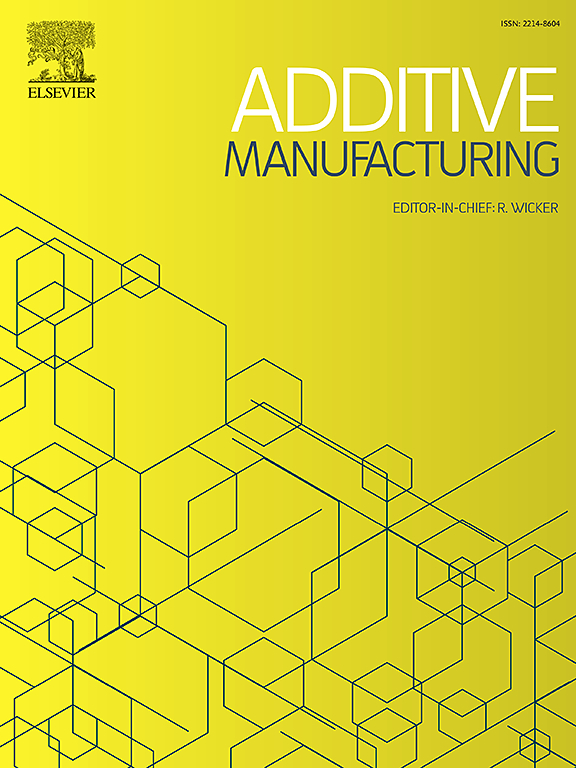Identifying thermal effects during 3D printing by comparing in-layer infrared pre- and postheating of carbon fiber reinforced polyamide 6
IF 10.3
1区 工程技术
Q1 ENGINEERING, MANUFACTURING
引用次数: 0
Abstract
Additive manufacturing technologies, particularly Material Extrusion (MEX), are rapidly evolving and gaining widespread adoption. However, parts produced by MEX often suffer from poor out-of-plane mechanical properties. Thus, to learn more about the fusion process of succeeding layers, this study investigates and compares the thermal and strength effects of in-layer infrared (IR) pre- and postheating during MEX 3D printing of carbon fiber reinforced polyamide 6 (PA6-CF). An experimental setup using a ∼40 W halogen bulb as an auxiliary heater was developed to compare no heating, preheating, and postheating configurations at print speeds ranging from 3 to 50 mm/s to manufacture single-wall tensile samples with 0.8 mm wall thickness and 0.3 mm layer height. Layer temperature, TL, and maximum temperature resulting from the external heater, TH, were measured for all heating configurations using infrared imaging. Thermal increase, ΔTPre, and ΔTPost was calculated from these two values and compared at various print speeds. An experimental estimate of thermal increase, ΔTT, was also defined to aid in the explanation of the observed strength effects and how they relate to the thermal evolution of the layer fusion process. Tensile testing was conducted to evaluate interlayer strength and correlated to the thermal measurements.
Results revealed thermal increase caused by IR heating at slower speeds and residual heat accumulation at higher speeds, both positively impacting strength. Postheating showcased a maximum TH of 272.9 ± 5.2°C and a maximum UTS of 59.84 MPa whereas preheating exhibited 219.2 ± 2.8°C and 52.28 MPa at a print speed of 3 mm/s. In addition, postheating demonstrated tensile samples with fracture across several layers, indicating strong layer adhesion. Even though postheating was found to be more effective at lower speeds, preheating produced stronger tensile tests at higher speeds. In answer to this result, the study introduces the concept of Layer Fusion Evolution (LFE) to hypothesize on how the two top layers fuse together under the different IR heating configurations. Based on the insights from the presented hypothesis and the experimental estimate of thermal increase, a model is presented and compared to the strength results as a possible explanation of why preheating and postheating performs differently across various print speeds. This model exhibits the same trend as the strength measurements across different speeds, and due to the previously linked property of weld temperature and strength, supports the presented hypothesis.
Furthermore the paper discusses future work and implementation of the findings and how they may aid in optimizing auxiliary heating strategies for MEX processes to improve out-of-plane mechanical properties and reduce the anisotropy in 3D printed components.
快速成型制造技术,尤其是材料挤压(MEX)技术,正在迅速发展并得到广泛应用。然而,用 MEX 生产的零件往往具有较差的平面外机械性能。因此,为了进一步了解后续层的融合过程,本研究调查并比较了在碳纤维增强聚酰胺 6(PA6-CF)的 MEX 3D 打印过程中,层内红外(IR)预热和后热的热效应和强度效应。实验设置使用一个 ∼40 W 卤素灯泡作为辅助加热器,在打印速度为 3 至 50 mm/s 的情况下,比较无加热、预热和后加热配置,以制造壁厚为 0.8 mm、层高为 0.3 mm 的单壁拉伸样品。使用红外成像技术测量了所有加热配置的层温 TL 和外部加热器产生的最高温度 TH。根据这两个值计算出热增加值 ΔTPre 和 ΔTPost,并在不同的打印速度下进行比较。此外,还定义了热增量的实验估计值 ΔTT,以帮助解释观察到的强度效应及其与层融合过程的热演变之间的关系。拉伸测试用于评估层间强度,并与热测量结果相关联。结果表明,红外加热在速度较慢时会导致热量增加,而在速度较高时则会导致余热积累,两者都会对强度产生积极影响。后加热的最大 TH 值为 272.9 ± 5.2°C,最大 UTS 值为 59.84 MPa,而预热的最大 TH 值为 219.2 ± 2.8°C,最大 UTS 值为 52.28 MPa(打印速度为 3 mm/s)。此外,后加热显示出拉伸样品在几个层之间断裂,表明层间粘合力很强。尽管后加热在较低的速度下更为有效,但在较高的速度下,预热会产生更强的拉伸测试。针对这一结果,研究引入了层融合演化(LFE)的概念,以假设在不同的红外加热配置下,两个顶层是如何融合在一起的。根据所提出假设的见解和实验对热量增加的估计,我们提出了一个模型,并将其与强度结果进行比较,以解释为什么预热和后加热在不同的打印速度下表现不同。此外,论文还讨论了未来的工作和研究结果的实施,以及如何帮助优化 MEX 工艺的辅助加热策略,以改善面外机械性能并减少 3D 打印部件中的各向异性。
本文章由计算机程序翻译,如有差异,请以英文原文为准。
求助全文
约1分钟内获得全文
求助全文
来源期刊

Additive manufacturing
Materials Science-General Materials Science
CiteScore
19.80
自引率
12.70%
发文量
648
审稿时长
35 days
期刊介绍:
Additive Manufacturing stands as a peer-reviewed journal dedicated to delivering high-quality research papers and reviews in the field of additive manufacturing, serving both academia and industry leaders. The journal's objective is to recognize the innovative essence of additive manufacturing and its diverse applications, providing a comprehensive overview of current developments and future prospects.
The transformative potential of additive manufacturing technologies in product design and manufacturing is poised to disrupt traditional approaches. In response to this paradigm shift, a distinctive and comprehensive publication outlet was essential. Additive Manufacturing fulfills this need, offering a platform for engineers, materials scientists, and practitioners across academia and various industries to document and share innovations in these evolving technologies.
 求助内容:
求助内容: 应助结果提醒方式:
应助结果提醒方式:


